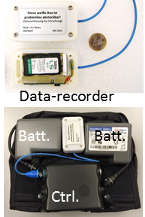Monitoring and Control for Left Ventricular Assist Devices
Systems for continuous out-of-hospital monitoring of rotary blood pump patients

A portable data acquisition system to record pump data continuously and to monitor activity with a tri-axial accelerometer, developed at the Medical University of Vienna, in collaboration with the Boltzmann Cluster of Cardiovascular Research was developed. Within the project, software for presentation and analysis or large scale patient data was developed. Since 2014 a database containing pump and activity data was established with over 9000 patient days from a total of 46 LVAD patients.
Development of Pump-Monitoring tools

A wide range of algorithms were developed to evaluate patient hemodynamics. Using sensorless derived pump data only it is possible to estimate pump flow and derive other hemodynamic parameters such as the status of the aortic valve, the contractility of the ventricle, heart rhythm, the relaxation of the ventricle and whether the pump is causing the ventricle to collapse: a mechanism called suction. Additionally, based on pump power uptake it is possible to predict adverse events such as upcoming pump thrombosis.
Ventricular Support Systems during exercise

Exercise physiology during VAD support is studied via previously developed pump-monitoring algorithms algorithms in combination with activity data from cardiac rehabilitation sessions. The heterogeneous hemodynamic responses to exercise can be studied and offer a clearer picture of patient status. Comparisons with numerical simulation allow understanding of similarities with typical hemodynamic scenarios such as reduced contractilities or poorer chronotropic response.
